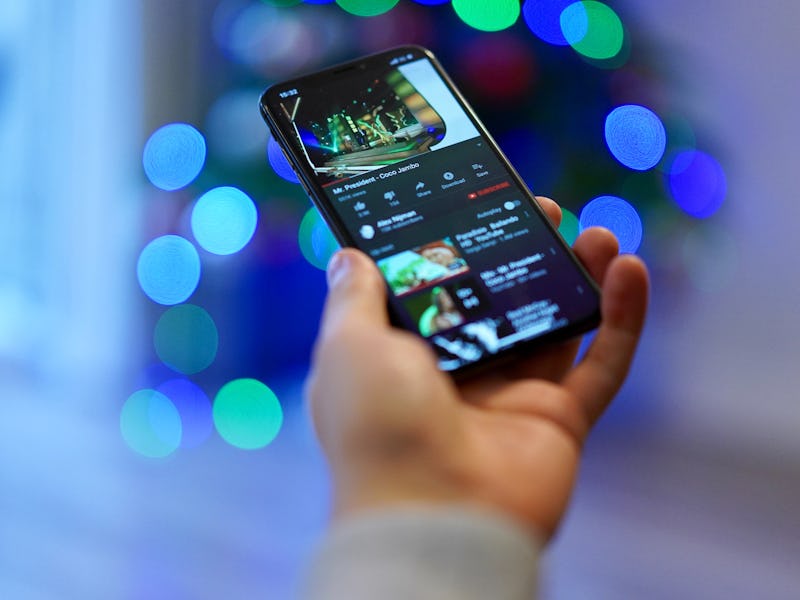How Your Phone's Screen Size Changes the Way You React to the News
This shift "may be problematic for political engagement."

Watching a quick rundown of a presidential debate on your phone is convenient, but what we gain in ease we may lose in impact. Even if we feel like we’re attentively watching news segments unfold on our index card-sized screens, the results of research in Information, Communication and Society published in June suggests that those small screens may change how that new information sinks in.
"Smaller screens are associated with reductions in activation and attention."
The study showed that 113 study participants who watched the news on a phone-sized screen were far less moved, psychologically and physiologically, by the content they saw, compared to people who watched bigger screens. And when people aren’t moved by what they see, they don’t tend to pay as much attention to it, explains study co-author Stuart Soroka, Ph.D., a professor of communication studies and political science at the University of Michigan.
In other words, we may be consuming a ton of news when we can load it anytime we want on our phones, but it’s not leaving the same mental mark that it would if we saw it on a laptop or a TV.
“Smaller screens are associated with reductions in activation and attention,” Soroka tells Inverse. “The main implication of our work is that, holding other things constant, a person that follows video news on a mobile screen will have less ‘cognitive access’ to that content than will a person who follows video news on a larger screen.”
From a physiological standpoint, Soroka showed that we're less "aroused" by news segments viewed on a smaller screen, like a phone.
Between 2013 and 2016, the Pew Research Center estimated that the number of Americans who received news from mobile sources jumped from 53 percent to 72 percent. When it comes to watching the crucial political moves over the next few months, Soroka’s research suggests that this shift “may be problematic for political engagement.”
The Effect of Small Screens
Previous research suggests that when we watch a movie on a big screen, it can elevate our internal reactions by changing our heart rate or skin conductance — electrical impulses generated by the skin that signal an emotional reaction. In the new study, Soroka and his colleagues observed that the pattern also holds true for less dramatic content (depending on your attitude), like news segments.
In the experiment, the participants watched a series of different news segments on either a 13-inch screen or a 4.5-inch screen. As they watched, the team measured two metrics of physiological “arousal”: heart rate and skin conductance.
Smaller screen size affected how the body reacted to what was unfolding on that screen. In particular, heart rate variability decreased when viewers saw news clips on a smaller screen. Skin conductance, meanwhile, didn’t decrease significantly.
People who watched news on a phone-sized screen showed fewer signs of arousal than those who watched on a laptop-sized screen.
The authors argue that their results are a “strong indication that screen size matters for some measures of cognitive access to news content” because of a connection between arousal and the “cognitive availability” of what we watch.
Heart rate and skin conductance are linked to the way news-watching activates our parasympathetic and sympathetic nervous systems. The latter is the motivator behind the fight or flight response, whereas the former, sometimes called the “rest and digest response,” is responsible for the opposite.
Heart rate is controlled by both nervous systems, rising in response to the sympathetic system and slowing in response to the parasympathetic nervous system. The way the body manages those reactions while it’s exposed to new content, Soroka posits, impacts how that information is processed.
“There is a fair bit of work in communication and media psychology that links activation in the sympathetic and/or parasympathetic nervous system with information processing and cognitive engagement,” Soroka explains. “For these reasons, we regard the measures as useful indications of cognitive access to information.”
Smaller screen size, going by his results, seems to blunt physiological arousal, which in turn may impact how much of the news sticks with us.
Soroka’s experiment didn’t measure that long-term effect directly, but his early results suggest that there are tangible differences to watching the news on a small, phone-sized screen. If we’re looking to make that information sink in, it may be worth opting for the TV. But if you’re okay with missing a few things, watching on the phone could be a way to go.
Abstract:
Smartphones are expanding physical access to news and political information by making access to the internet available to more people, at more times throughout the day, and in more locations than ever before. But how does the portability of smartphones — afforded by their small size — affect cognitive access to news? Specifically, how do smartphone-size screens constrain attentiveness and arousal? We investigate how mobile technology constrains cognitive engagement through a lab-experimental study of individuals’ psychophysiological responses to network news on screens the size of a typical laptop computer, versus a typical smartphone. We explore heart rate variability, skin conductance levels, and the connection between skin conductance and the tone of news content. Results suggest lower levels of cognitive access to video news content on a mobile- sized screen, which has potentially important consequences for public attention to current affairs in an increasingly mobile media environment.